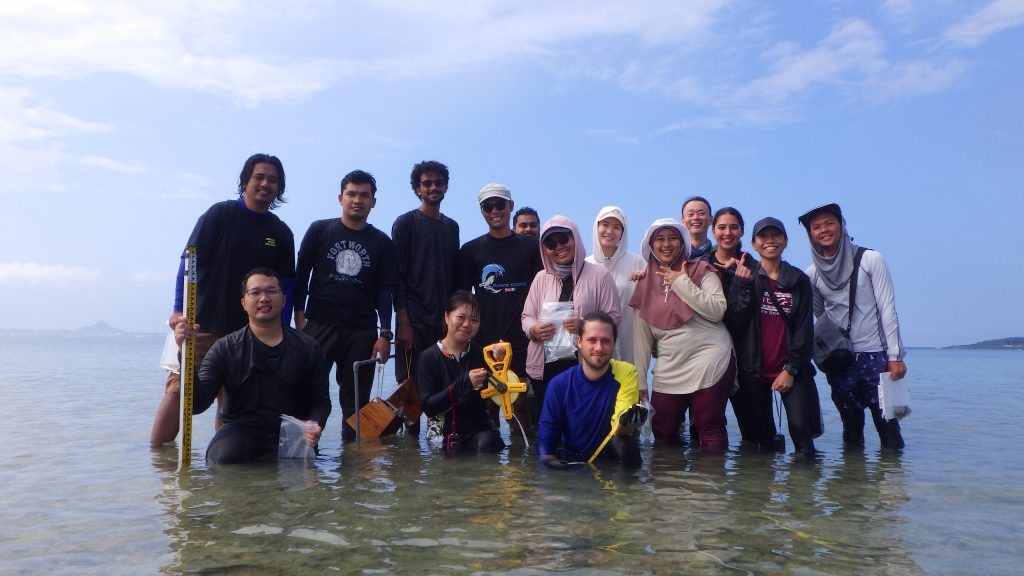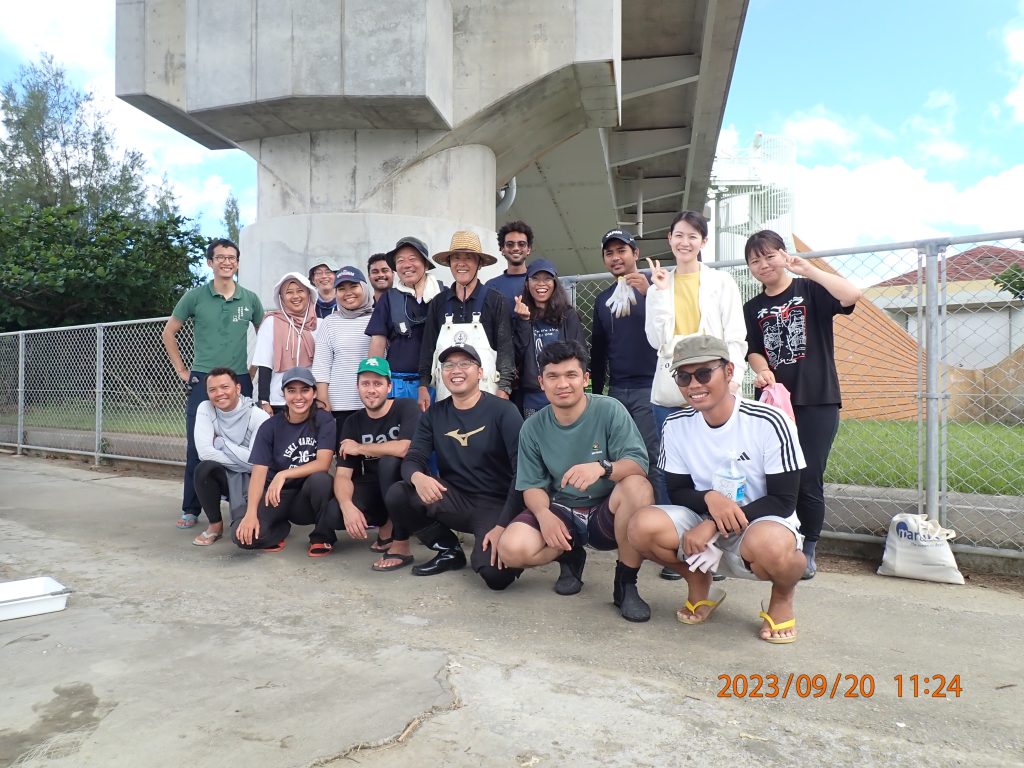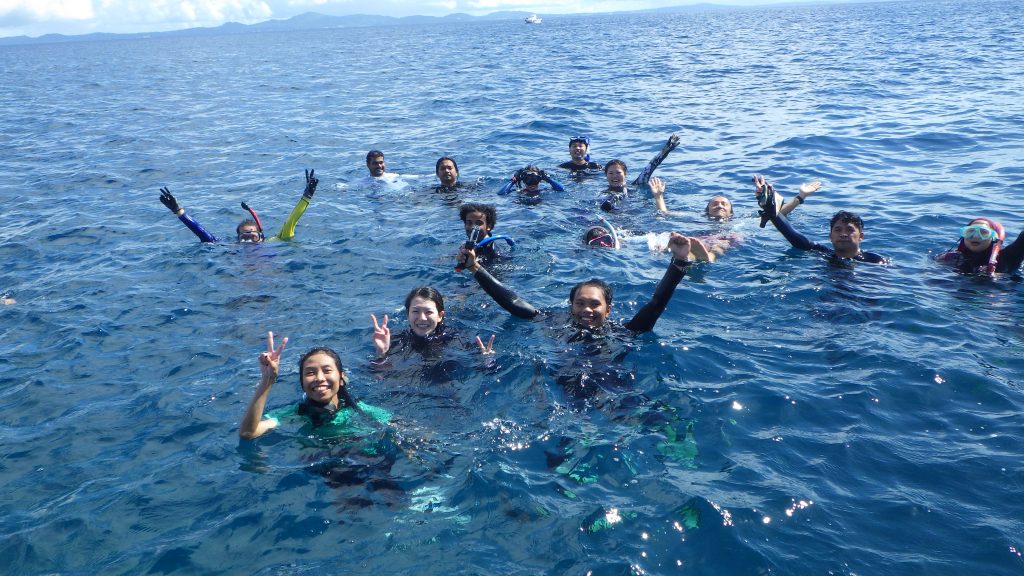お知らせ
国際フィールドコース実施報告 Report on International Field Course
*English follows.
9月19~21日に熱帯生物圏研究センター瀬底研究施設を利用して国際フィールドコースを実施しました。
この科目は英語の授業で、海洋環境や海洋生物資源に関する幅広い知識や技術を身につけることに加えて、
留学生特別プログラム(LA MERプログラム)の留学生間の交流を深めることが目的です。
今年度は12名の留学生と2名の日本人大学院生が参加しました。
1日目は地学系の藤田先生が担当し、午前のオリエンテーションと気候変動とサンゴ礁の応答に関する講義のあと、
瀬底ビーチでサンゴ礁の測線調査を役割分担を決めて行いました。
サンゴ礁がサンゴだけでなく、サンゴモや有孔虫などの石灰化生物やウニなどによる生物浸食によってできていることを学びました。
測線調査の結果を全員で一つのレポートとしてまとめました。

1日目の様子
2日目は生物系の今井先生と小枝先生が担当し、水産魚介類についての実習が行われました。
3つのグループに分かれて名護漁港での魚種調査を行った後、羽地漁港で漁船に乗って小型定置網漁と刺し網漁を体験しました。
その後実習室に戻ってから漁港や漁で撮影した魚介類を同定し、成果をプレゼン発表しました。
琉球列島の魚介類の多様性と水産資源の重要性を学びました。
夜はバーベキューで親睦を深めました。漁で採取した蟹や刺身も美味しくいただきました。

2日目の様子
3日目は瀬底研究施設の守田先生が担当し、ミドリイシ属サンゴの生物学の講義のあと、スノーケルで瀬底研究施設前や水納島でサンゴの観察を行いました。
サンゴの種類や白化状況について調べ、サンゴ礁生態系の現状についての理解を共有しました。
今回の実習は西原キャンパスと瀬底研究施設の留学生間や日本人大学院生と留学生間の交流の機会としても非常に重要であったようです。
来年度以降も継続して実施していきたいと考えています。
日本人大学生の積極的な参加にも期待しています。

3日目(最終日)の様子
The International Field Course was held from September 19-21 at the Sesoko Research Station of the Tropical Biosphere Research Center. The purpose of this field course was to acquire a wide range of knowledge and skills regarding the marine environment and marine living resources and also to deepen exchanges among international students belonging to the Graduate School Special Program (LA MER Program). Participants included 12 international students with two Japanese graduate students.
The first day was led by Professor Fujita (geoscience section). After a morning orientation and a lecture on climate change and the responses of coral reefs, students conducted a line transect survey at Sesoko beach, each having a different role. We learned that coral reefs are formed not only by corals, but also by coralline algae, foraminiferal shells, and by the biological erosion of sea urchins, etc. We compiled results of the survey into a single report.

1st Day
On the second day, Professors Imai and Koeda (biology section) were in charge of fish and shellfish taxonomy. After dividing into three groups, a fish species survey was conducted at Nago Fishing Port, and then students boarded a fishing boat at Haneji Fishing Port and experienced small set-net and gill-net fishing. After returning to Sesoko Station, the students identified the fish and shellfish photographed at the fishing port and fishing, and each group presented their results. Students learned the diversity of fish and shellfish in the Ryukyu Islands and their importance as fishery resources.
In the evening, we deepened our friendships over a BBQ. We ate delicious boiled crabs and freshly-caught sashimi.

2nd Day
On the third day, Professor Morita from the Sesoko Research Station gave a lecture on the biology of acroporid corals, then snorkeled to observe corals in front of Sesoko Research Station and off Minna Island. The students observed various coral types and bleaching status, and shared their understanding of the current state of coral reef ecosystems.
This course was a very important opportunity for exchange between international students at Nishihara Campus and Sesoko Research Station, as well as between Japanese graduate students and international students. We will continue this course next year and into the future, and hope for participation from more Japanese graduate students next time.

3rd(Final) Day

